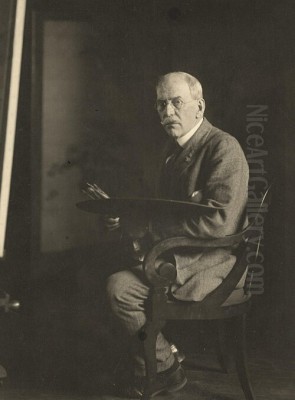
Joseph Rodefer DeCamp stands as a significant figure in the landscape of American art, particularly renowned for his contributions to Impressionism and his pivotal role within the Boston School of painting. His career, spanning the late 19th and early 20th centuries, was marked by a dedication to refined technique, a sensitive portrayal of his subjects, and an evolving style that embraced both academic tradition and modern artistic currents. As a painter and an influential educator, DeCamp left an indelible mark on his contemporaries and subsequent generations of artists.
Early Life and Artistic Awakening in Cincinnati
Born on November 5, 1858, in Cincinnati, Ohio, Joseph Rodefer DeCamp's artistic journey began in a city that was, at the time, a burgeoning center for arts and culture in the American Midwest. His initial formal training commenced at the McMicken School of Design (later the Art Academy of Cincinnati). It was here that he encountered Frank Duveneck, a charismatic and highly skilled painter who had recently returned from his studies in Munich.
Duveneck's influence on DeCamp and a group of other young Cincinnati artists, often referred to as the "Duveneck Boys," was profound. Duveneck championed a vigorous, direct painting style characterized by rich, dark palettes and bravura brushwork, heavily influenced by the realism of the Munich School and masters like Wilhelm Leibl. DeCamp absorbed these lessons, developing a strong foundation in draftsmanship and a painterly approach that would inform his work throughout his career, even as his style evolved. Other artists who were part of this vibrant Cincinnati scene and associated with Duveneck included John Henry Twachtman and Robert Frederick Blum, both of whom would also go on to achieve national recognition.
European Sojourn and Formative Influences
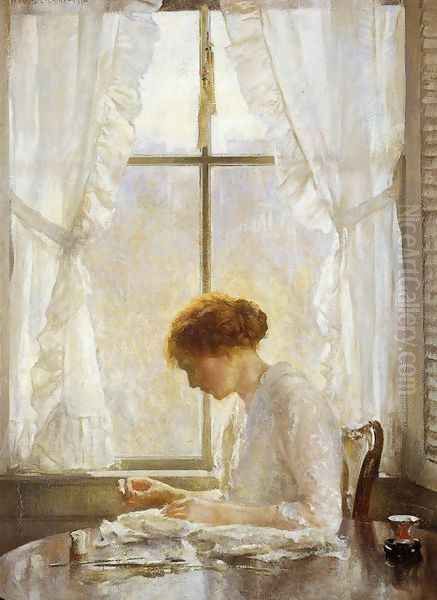
In the late 1870s, following a common path for ambitious American artists of his generation, DeCamp traveled to Europe to further his artistic education. He enrolled at the Royal Academy of Munich, where Duveneck himself had studied and was then teaching. The Munich School's emphasis on realism, tonal harmony, and direct observation of the subject continued to shape DeCamp's artistic sensibilities. He, along with Duveneck and other American students like William Merritt Chase and Walter Shirlaw, immersed himself in the academic environment, honing his skills in figure painting and portraiture.
After his time in Munich, DeCamp, often in the company of Duveneck and fellow students, traveled to Italy. He spent time in Florence and Venice, studying the works of the Old Masters and absorbing the rich artistic heritage of the Italian Renaissance. This period was crucial for broadening his artistic horizons, exposing him to different approaches to composition, color, and light beyond the more somber tones prevalent in Munich. The vibrant light and classical forms of Italy undoubtedly left an impression, subtly influencing the direction his art would later take.
Return to America and the Boston School
Joseph DeCamp returned to the United States in 1883, choosing Boston as his new home. Boston, at this time, was a major cultural and intellectual hub, with a thriving art scene. He quickly established himself as a prominent figure, becoming closely associated with what would become known as the Boston School of painting. This group, which included other leading artists such as Edmund C. Tarbell and Frank W. Benson (both of whom had also studied in Europe, though primarily in Paris), developed a distinctive style characterized by academic draftsmanship, refined aesthetics, and an Impressionistic concern for light and atmosphere.
The Boston School painters often focused on elegant depictions of women in sunlit interiors, portraits of prominent individuals, and serene landscapes. DeCamp excelled in figure painting and portraiture, gaining a reputation for his ability to capture not only a likeness but also the personality and inner life of his sitters. His work from this period demonstrates a sophisticated understanding of form, a subtle use of color, and a masterful handling of light to create a sense of intimacy and psychological depth. He became a sought-after portraitist, receiving commissions from many notable figures of the era. Other painters associated with the spirit of the Boston School, though perhaps with stylistic variations, included William McGregor Paxton and Philip Leslie Hale.
The Ten American Painters
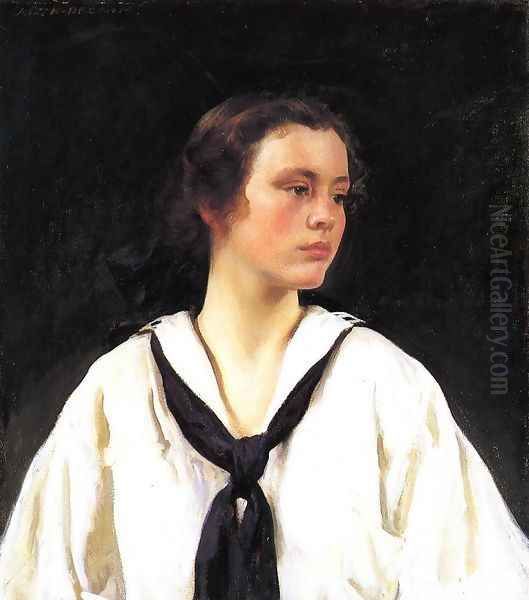
A defining moment in DeCamp's career, and in the history of American Impressionism, was his role as a founding member of "The Ten American Painters" in 1897. This group, often simply called "The Ten," was formed out of dissatisfaction with the conservative exhibition policies of the Society of American Artists. The founding members, in addition to DeCamp, Tarbell, and Benson, were Childe Hassam, John Henry Twachtman, J. Alden Weir, Robert Reid, Edward Simmons, Thomas Wilmer Dewing, and Willard Metcalf. After Twachtman's death in 1902, William Merritt Chase was invited to join.
The Ten sought greater artistic freedom and opportunities to exhibit their work in smaller, more harmonious shows that highlighted their shared, though individually distinct, commitment to modern artistic principles, largely influenced by French Impressionism. They emphasized painterly quality, the effects of light and color, and contemporary subject matter. DeCamp actively participated in their annual exhibitions, which were held in New York, Boston, and other American cities, contributing significantly to the group's prestige and the growing acceptance of Impressionism in the United States. His involvement with The Ten solidified his position as a leading figure in American art at the turn of the century.
Artistic Style and Thematic Concerns
Joseph DeCamp's artistic style evolved throughout his career, but it consistently demonstrated a strong foundation in academic realism combined with an Impressionistic sensitivity to light and color. In his early work, influenced by Duveneck and the Munich School, he employed a darker palette and vigorous brushwork. However, as he matured, particularly after his return to Boston and his association with The Ten, his palette lightened, and his handling of paint became more nuanced, reflecting the influence of Impressionism.
DeCamp was particularly renowned for his figure paintings and portraits. He had a remarkable ability to render the human form with solidity and grace, capturing subtle expressions and gestures that conveyed the sitter's character. His female figures, often depicted in domestic interiors engaged in quiet activities like sewing or reading, are imbued with a sense of dignity and introspection. He masterfully handled the play of light on fabric and flesh, creating luminous and atmospheric effects. While he embraced Impressionistic techniques, his work always retained a strong sense of underlying structure and form, distinguishing him from some of the more purely optical approaches of French Impressionism.

Beyond figures and portraits, DeCamp also painted landscapes and, occasionally, still lifes. His landscapes, though less numerous than his figural work, show a keen observation of nature and a similar concern for capturing the fleeting effects of light and atmosphere. He also explored Tonalism, an American art movement characterized by soft, diffused light, muted colors, and evocative moods, which can be seen in some of his more atmospheric pieces.
Notable Works
Several paintings stand out as representative of Joseph Rodefer DeCamp's mature style and artistic achievements. Perhaps his most famous work is The Seamstress (also known as Woman Sewing or The Blue Locket), painted around 1916. This exquisite painting depicts a young woman absorbed in her needlework, seated near a window that bathes the scene in a soft, natural light. The composition is balanced and harmonious, with a delicate interplay of cool blues, grays, and whites. DeCamp's masterful rendering of the textures of the woman's dress, the subtle modeling of her features, and the overall serene atmosphere make this a quintessential example of the Boston School's aesthetic. It showcases his ability to combine technical skill with emotional sensitivity.
Another significant work is The Red Kimono (c. 1910s). This painting reflects the Japonisme trend that was popular among Western artists at the time, an interest in Japanese art and aesthetics. The subject, a woman in a vibrant red kimono, is rendered with DeCamp's characteristic attention to form and light, but the composition and decorative elements, such as the patterned screen in the background, show an engagement with Eastern artistic conventions. The bold color of the kimono and the elegant pose of the figure create a striking and memorable image.
His portraits, such as that of President Theodore Roosevelt (commissioned for Harvard University), demonstrate his skill in capturing a strong likeness and conveying the sitter's public persona. Other important works include Sally (a tender portrait of a young girl), The Guitar Player, and numerous depictions of refined women in interior settings, all of which highlight his consistent quality and artistic vision. Many of his earlier works, unfortunately, were lost in a fire in his Boston studio in 1904, a significant blow to his oeuvre.
A Dedicated Educator
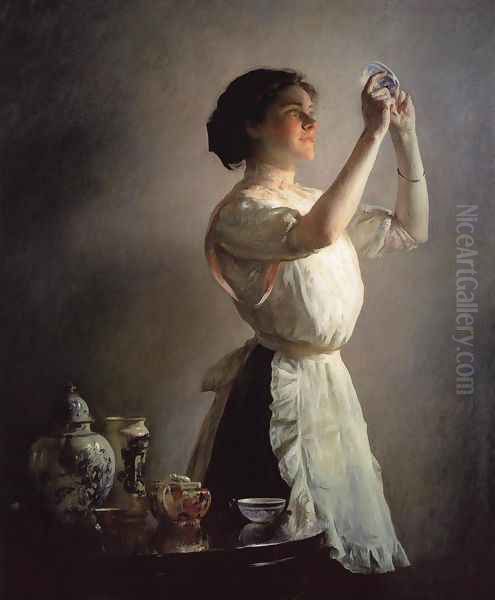
Beyond his achievements as a painter, Joseph DeCamp was a highly respected and influential educator. He held teaching positions at several prominent institutions, most notably the Massachusetts Normal Art School (now the Massachusetts College of Art and Design) and the School of the Museum of Fine Arts, Boston. At these schools, he instructed generations of aspiring artists, passing on the principles of sound draftsmanship, color theory, and compositional harmony that he had mastered.
His teaching philosophy emphasized a rigorous approach to observation and technique, combined with an encouragement of individual expression. He was known for his insightful critiques and his ability to inspire his students. Many artists who studied under DeCamp went on to have successful careers, and his influence helped to shape the direction of art education in Boston and beyond. His dedication to teaching demonstrates his commitment to fostering artistic talent and ensuring the continuation of high standards in American art. He was also briefly offered a professorship at the Pennsylvania Academy of the Fine Arts, though health concerns reportedly led him to resign after a short period.
Challenges and Later Years
DeCamp's career was not without its challenges. The aforementioned studio fire in 1904 resulted in the tragic loss of hundreds of his early paintings, sketches, and studies. This event was a considerable setback, destroying a significant portion of his life's work up to that point. Despite this, he persevered and continued to produce important works in the subsequent years.
In his later life, DeCamp began to experience health problems. Around the age of 46, these issues started to affect his productivity, though he continued to paint and exhibit. He sought warmer climates for his health, spending time in Florida. Joseph Rodefer DeCamp passed away in Boca Grande, Florida, on February 11, 1923, at the age of 64.
Legacy and Enduring Influence
Joseph Rodefer DeCamp's legacy is that of a distinguished American painter and a key figure in the Boston School and the American Impressionist movement. His work is characterized by its technical excellence, refined beauty, and sensitive portrayal of the human figure. He successfully synthesized the academic traditions he learned in Europe with the modern sensibilities of Impressionism, creating a style that was both sophisticated and accessible.
His contributions as a founding member of The Ten American Painters were crucial in promoting Impressionism in the United States and challenging the established art institutions of the day. As an educator, he had a lasting impact on countless students, instilling in them a respect for craftsmanship and artistic integrity.
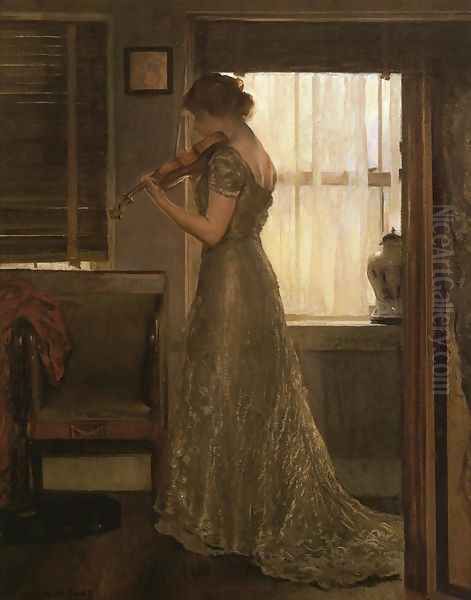
Today, DeCamp's paintings are held in the collections of major American museums, including the Museum of Fine Arts, Boston; the Metropolitan Museum of Art, New York; the National Gallery of Art, Washington, D.C.; the Cincinnati Art Museum; and the New Mexico Museum of Art, among others. His work continues to be admired for its elegance, its masterful handling of light and color, and its insightful depiction of American life at the turn of the 20th century. He remains an important artist for understanding the development of American art and the particular character of the Boston School, standing alongside contemporaries like John Singer Sargent, Mary Cassatt, and Winslow Homer in the pantheon of great American painters of his era.
Conclusion
Joseph Rodefer DeCamp's artistic journey from Cincinnati to the art capitals of Europe and finally to the forefront of the Boston art scene is a testament to his talent, dedication, and adaptability. He navigated the evolving artistic landscape of his time, embracing new ideas while remaining grounded in a strong technical foundation. His paintings, particularly his luminous depictions of women and his insightful portraits, continue to resonate with viewers, offering a glimpse into a world of quiet beauty and refined sensibility. As a painter, a leader among his peers in The Ten, and an influential teacher, DeCamp secured his place as a vital contributor to the rich tapestry of American art history.